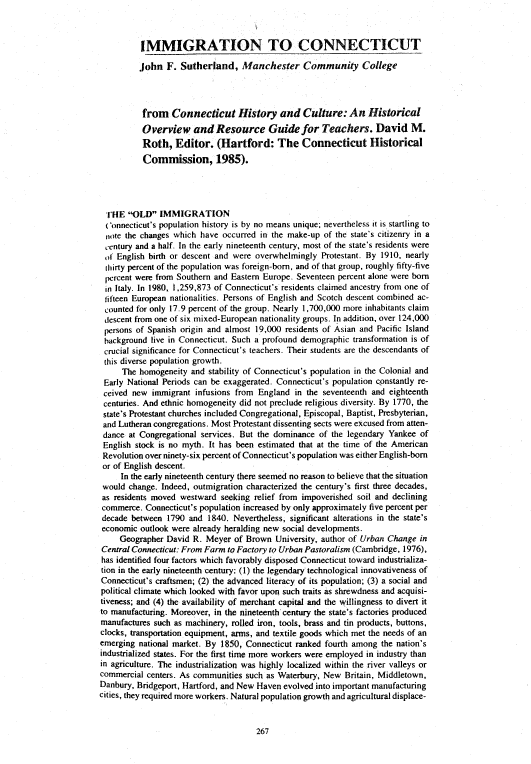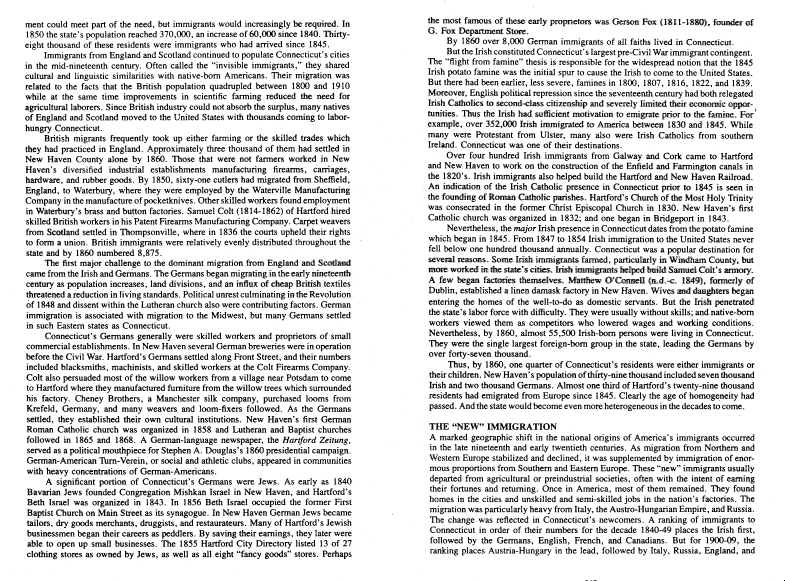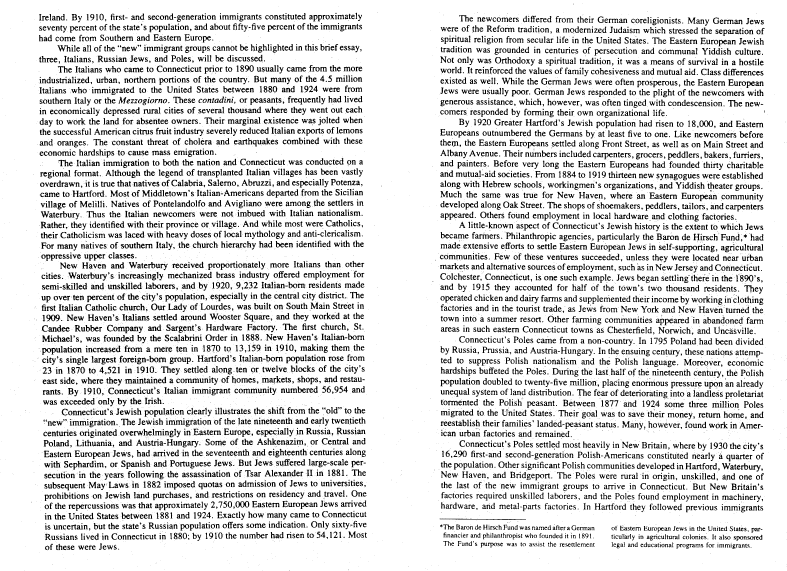Contents
The Promised Land in Connecticut?: Background Reading for Students
Works Project Administration (W.P.A.) Sources:
The unit consists mainly of primary source documents from the WPA Ethnic Group Survey grouped in the following sequence:
I. Immigrants & Second Generation Americans (WPA Interviews of the Irish in Bridgeport):
a] Mrs. Mary F..... was interviewed by M.V. Rourke (date uncertain, but found amongst interviews conducted in 1938).b] Mrs. Murphy was interviewed by Elizabeth M. Buckingham on Dec. 4, 1939.
II."Yankees" (WPA Interviews of the English & Scottish in New Haven):
a] Mr. K.... was interviewed by Marjorie Earle on March 27, 1940.b] Mr. Kenneth B. Morgan was interviewed by John P. Kilgore on July 8, 1940.
c] Mr. Henry A. Marshall was interviewed by John P. Kilgore on Aug. 12, 1940.
III.Second Generation Americans (an interview of a Jewish man and of an Afro-American in Bridgeport - WPA Interviews of two minorities traditionally persecuted in the United States):
a] Mr. Raphael Korff was interviewed by Edward Reich on July 7, 1939.b] Rev. Aaron J. Cuffey was interviewed by George A. Fisher on Jan. 18, 1939.
IV. Second Generation American: Marshall V. Rourke one of the WPA interviewer's, interviews himself on Jan. 4, 1939 (WPA Interview done by an Irish WPA Interviewer).
V. WPA Interview excerpts taken from From the Old Country: An Oral History of European Migration to America, ed. by Bruce Stave and John Sutherland (These include 1930's interviews of Sicilian-American, two Irish-Americans, and a Ukrainian-American).
"Immigration to Connecticut," by John F. Sutherland
This site was created by Mark Williams, a history teacher at The Loomis Chaffee School, Windsor, Connecticut, under a grant from the Connecticut Humanities Council. Some of the materials published here were originally created by Mark Williams as Connecticut Case Studies, under a grant from the Connecticut Humanities Council, and printed by the Hartford Steam Boiler Inspection and Insurance Company. John F. Sutherland of Manchester Community College, Ronald P. Dufour of Rhode Island College, Thomas P. Weinland of the University of Connecticut, Tracey Wilson of Conard High School, Robert K. Andrian of The Loomis Chaffee School, and State Historian Christopher Collier served as consultants. The Connecticut Humanities Council is the State Committee of the National Endowment for the Humanities. The viewpoints or recommendations expressed in the materials on this site of are not necessarily those of the Council or the Endowment. Teachers are encouraged to print and make copies of these materials for their students.
Background Reading for Students
Looking at the past experience of those first generations of immigrants to Connecticut, we find that their experience was often made more difficult by the permanently settled residents of the state. For a nation built upon the right of liberty and the equality of all mankind, we have sometimes shown disdain towards the most recent immigrants and shunned them because they were not native-born Americans.
The WPA was founded in the spring of 1933 under the Emergency Relief Appropriation Act. "From its creation until its demise in 1945, the WPA spent over $11 billion on work relief and ultimately employed eight million Americans, about one-fifth of the nation's entire workforce. ... WPA writers, for example, produced state and regional guidebooks and pioneering volumes in oral history, including narratives by former slaves" (Parrish, 347-8).
In Connecticut the WPA undertook a oral history program from 1938 through 1940, called the WPA Ethnic Group Survey. This project was directed nationality by the sociologist Samuel Koenig. As for how the interviews were conducted, these were based upon a series of questions the interviewers were required to ask the interviewee, "They were provided with a sample questionnaire that went into great detail concerning the homeland, family life, attitudes and values, religion, diet, recreation, reasons for emigration, first impressions of America, adjustment, and work"(Stave & Sutherland, xvi). In addition, the interviewers were instructed to read any pertinent materials that would explain some of the history and cultural characteristics of the ethnic group they would be interviewing.
By 1938 one notices the similarity between the rise of fascism (i.e., Hitler) and the coinciding anti-Semitic views expressed by some Americans at that same time. Furthermore, other prejudicial views against new immigrants to the United States were exacerbated by the tight labor market caused by The Great Depression. In addition, these views of inequality were even expressed between the different recent ethnic groups (some might even say a these were beliefs brought with them from the 'home' nations in Europe). Furthermore, the great economic hardships faced by first and second generation immigrants destroyed their dreams of America 'as the land of opportunity' and probably caused some to regret their migration to the U.S. As for the view of the 'land of the free', whereby all men are treated as equals based on the rights proclaimed in the U.S. Constitution, many of the immigrants to the U.S. during the early twentieth century were exposed to blatant prejudicial treatments and even laws restricting the emigration of immigrants from specific nations and regions. [i.e., the Chinese Exclusion Act of 1882, the Immigrant Restrictive League formed in 1894 (against the influx of Slav, Latin and Jews peoples), 'The Gentlemen's Agreement' of 1907-8, a literacy test for prospective immigrants passed in 1917, the Emergency Quota Act of 1921, etc. ].
Furthermore, although ethnic groups did assist their own, they usually shunned other ethnic groups, reflecting old European ethnic rivalries and distrust. In the early twentieth century, it seems as though America wasn't a great 'melting pot' of all the different cultures, but could have been associated as a great' tossed salad' of different ethnic groups.
"The Great Depression of the 1930's changed the patterns of immigration drastically. . . . The great drop in the number of immigrants from 241,700 in 1930 and 97,139 in 1931 is one of the significant demarcation points in the history of American immigration. Not until 1946 would as many as 100,000 persons again enter the country as immigrants. There were two obvious causes for the decline. In the first place the impact of the Great Depression was beginning to be felt. . . . In addition, the American government changed the rules and did so by executive order. In 1930 President Herbert Hoover issued an order to American consulates to interpret the long-standing LPC ("Likely to become a public charge") clause more rigidly. Previously, only persons who were obviously unable and/or unlikely to be able to support themselves had been kept out by that provision of the law:. . . Although Franklin Roosevelt revoked the executive order in 1936, many in the consular and diplomatic services continued to interpret the LPC clause in the new and restrictive way" (Daniels, 295). This new restriction placed on the number and type of immigrant allowed in the U.S. even prevented many European Jews escaping from the Nazi holocaust to enter legally into America.
As you read the primary sources and complete the activities I hope you realize the value of the diverse American population in the U.S. pre-World War II and the difficulties that this sometimes created.
Furthermore, please pay attention to limited assimilation into the 'American way of life' and the strife (& the outright racism) between the different ethnic groups during the late 1930's.
[A side note: the unit objectives and assignments are in the 'Teacher's Notes' and will be explained by your instructor].
A glossary of definitions* students can use:
1. Anti-Semitism- discrimination against or prejudice or hostility towards Jews.
2. Discriminate- to make a distinction in favor of or against a person on the basis of the group or class to which the person belongs, rather than according to merit.
[discrimination- the act or instance of discriminating].
3. Emigrate- to leave one country or region to settle in another; migrate.
4. Immigrant- a person who migrates to another country, usually for permanent residence.
5. Migrate- to move from one country , region, or place to another.
[ migrant- a person that migrates].
6. Nativism- the policy of protecting the interests of native inhabitants against those of immigrants; and/or The policy of preserving an indigenous [native] culture.
7. Prejudice- an unfavorable opinion or feeling formed beforehand or without knowledge or reason.
8. Racism*- a belief or doctrine that inherent differences among the various human races determine cultural or individual achievement; usually involving the idea that one's own race is superior.
[ * within some of the WPA interviews, the interviewee uses the term racism to refer to the differences between different Caucasian groups ].
9. Second generation Americans- the descendants of those who had migrated to a country; the children of immigrants.
10. 'Yankees'- a native or inhabitant of the United States.
11. Xenophobia- the fear or hatred of foreigners and/or strange customs.
( * these definitions are taken from the Webster's Universal College Dictionary; 1997 edition ).
I. Immigrants & Second Generation Americans (WPA Interviews of the Irish in Bridgeport):
a] Mrs. Mary F..... was interviewed by M.V. Rourke (date uncertain, but found amongst interviews conducted in 1938).
[image not ready yet]
b] Mrs. Murphy was interviewed by Elizabeth M. Buckingham on Dec. 4, 1939.
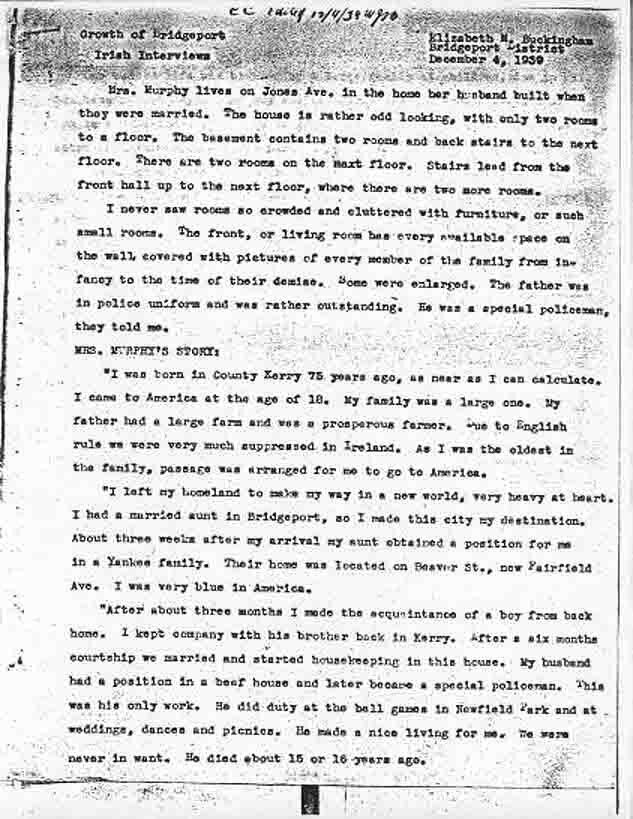
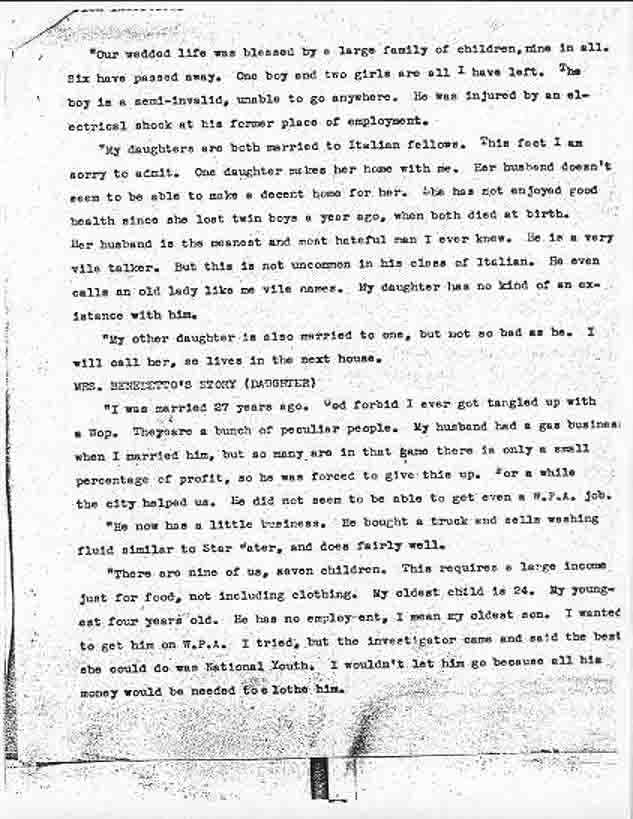
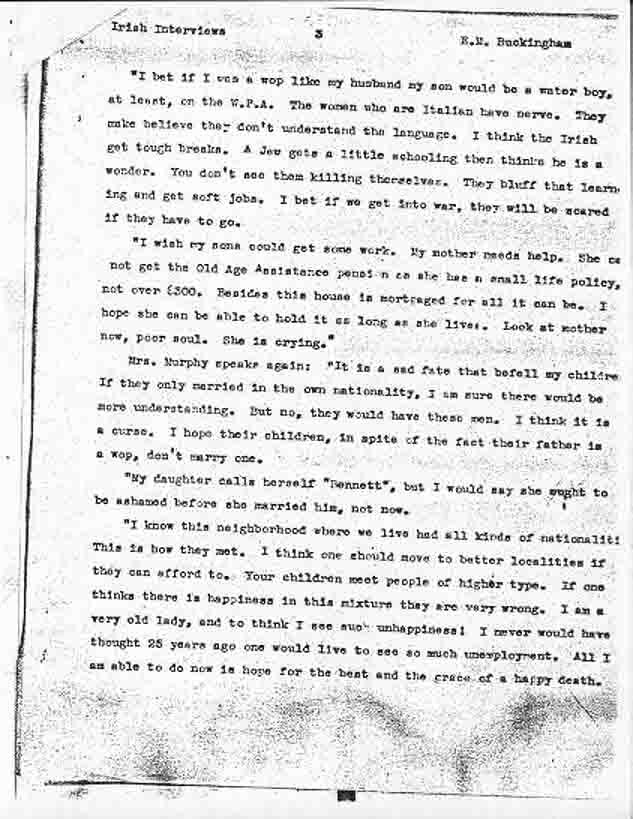
II."Yankees" (WPA Interviews of the English & Scottish in New Haven):
a] Mr. K.... was interviewed by Marjorie Earle on March 27, 1940.
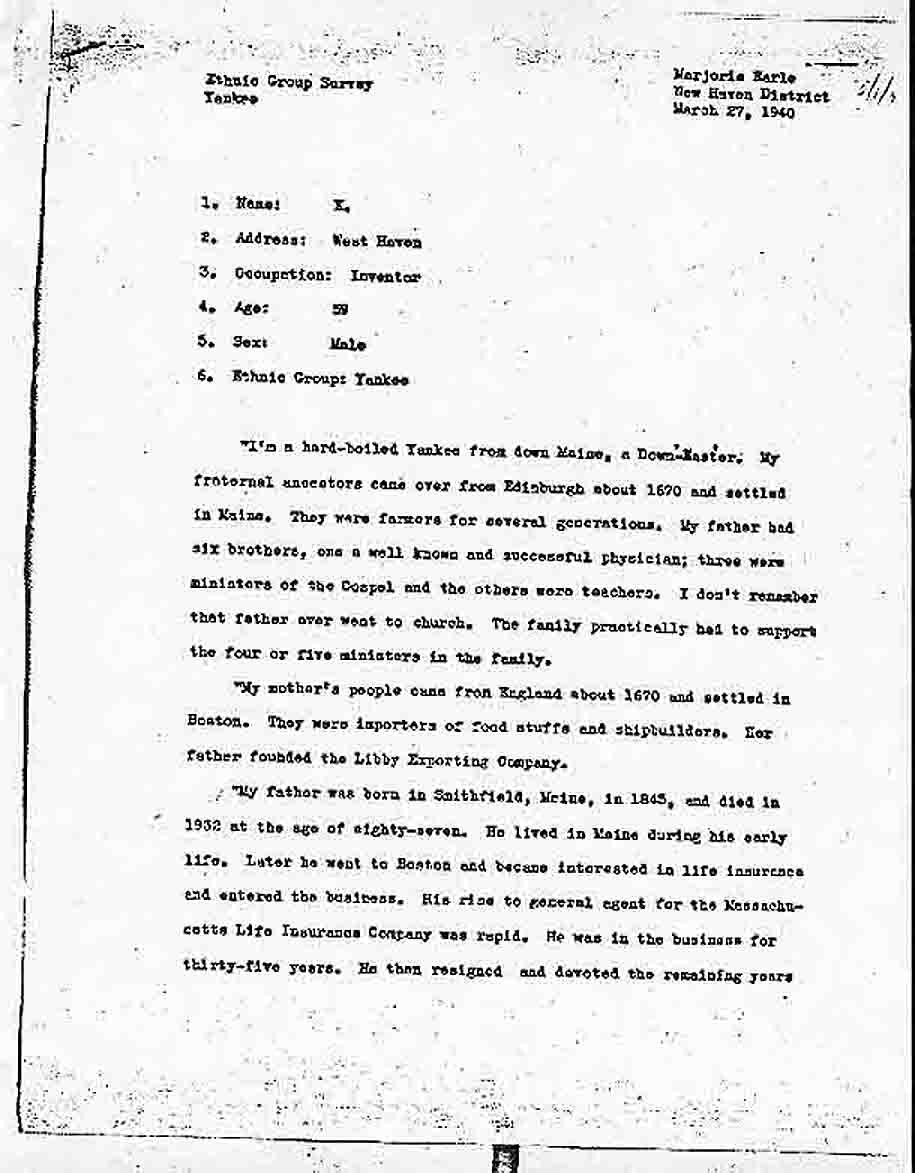
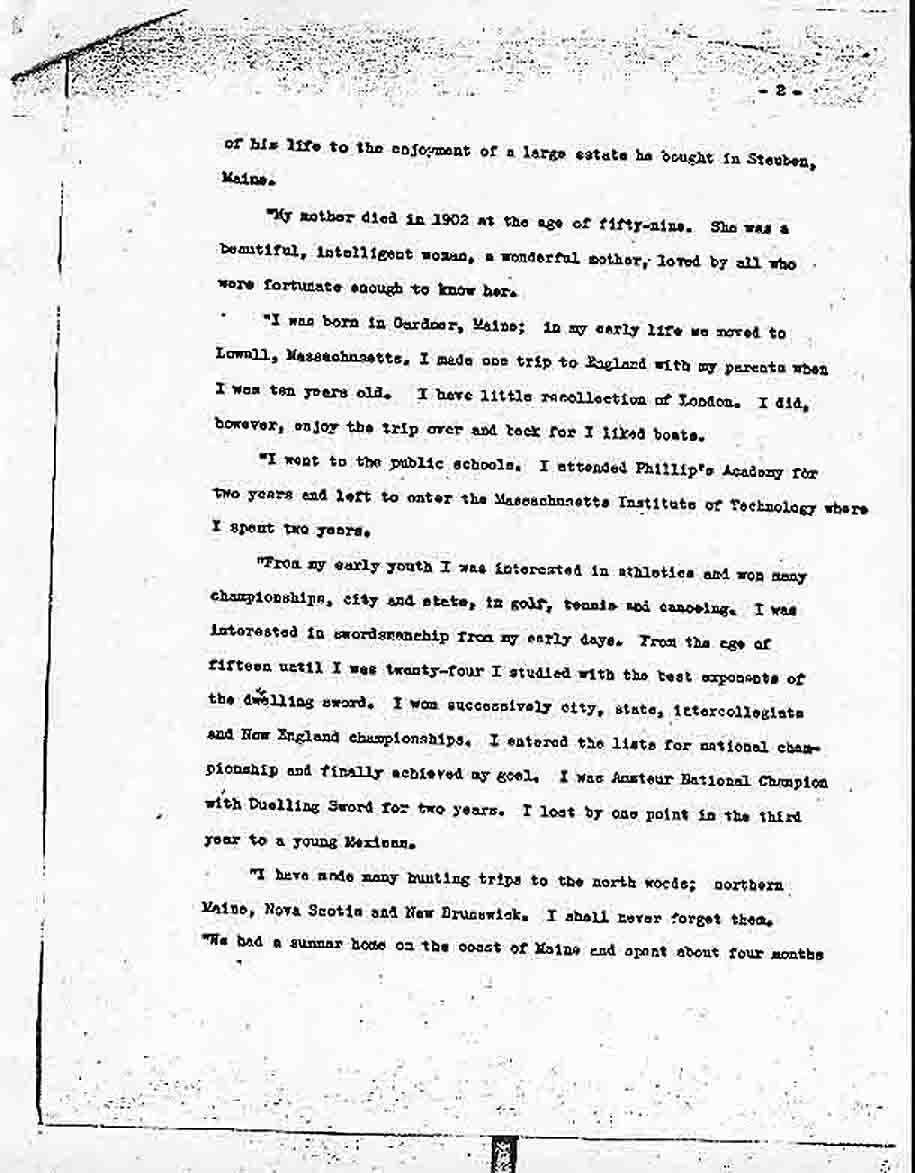
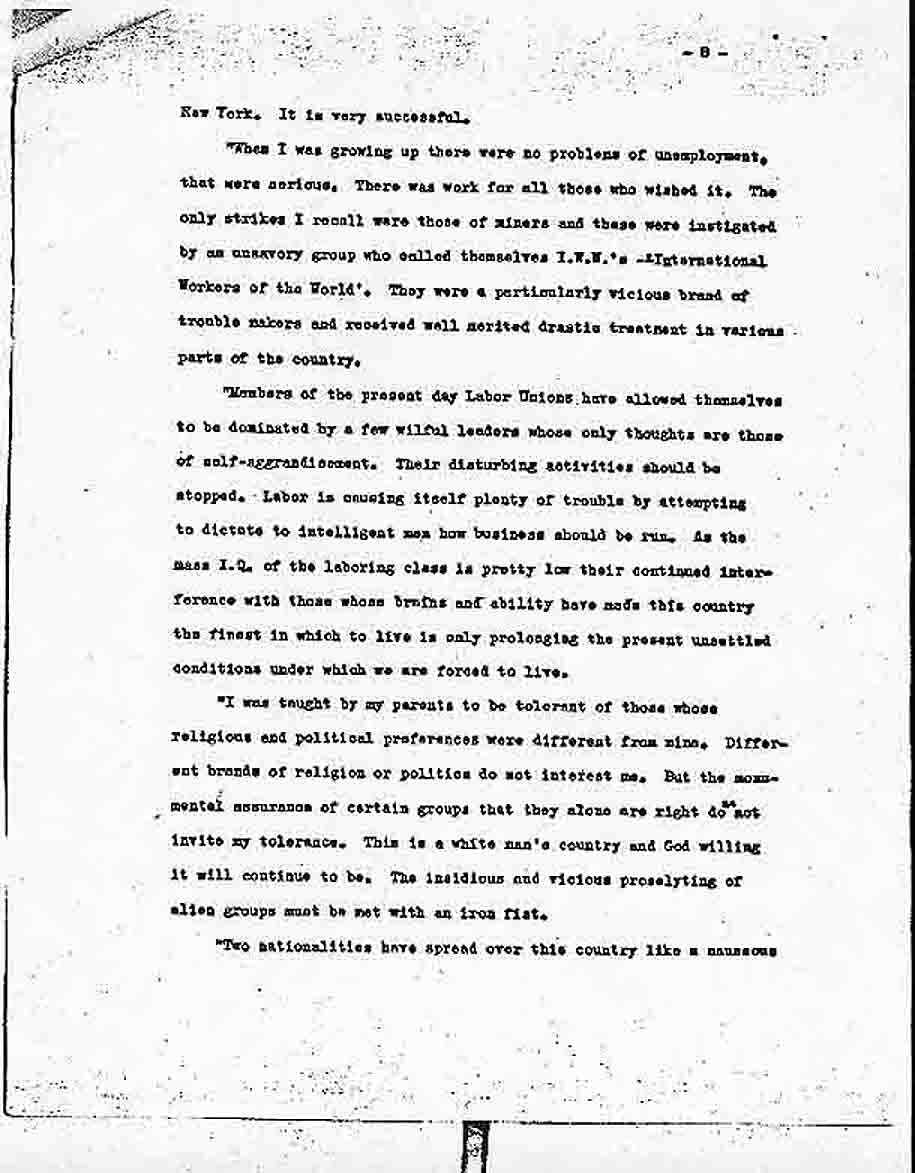
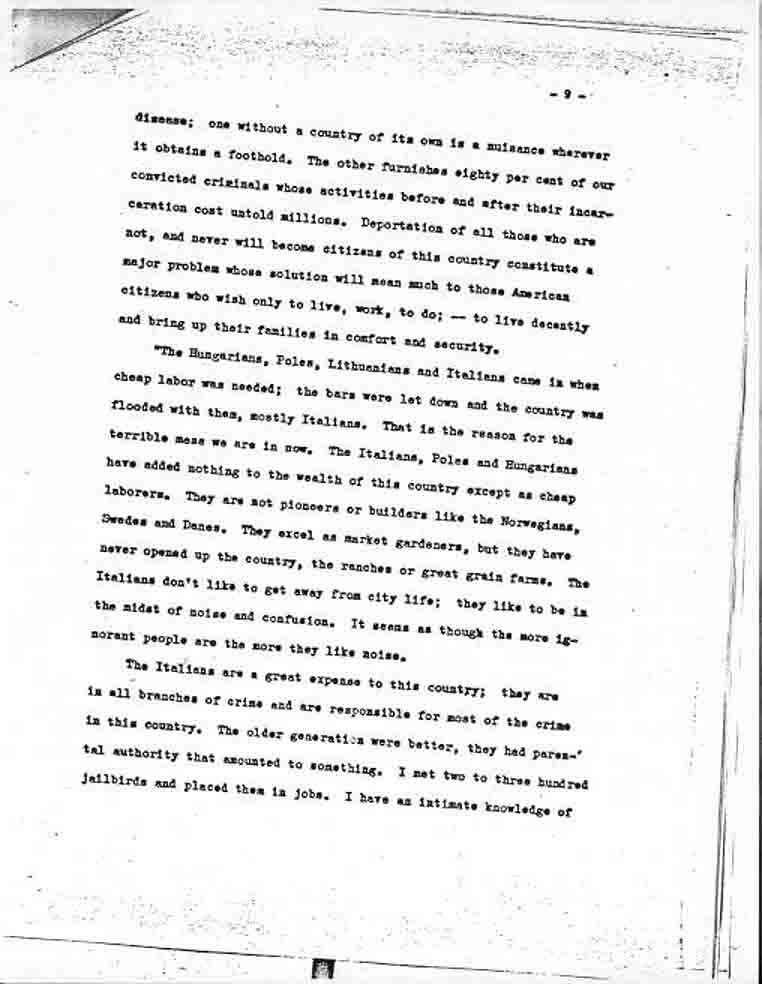
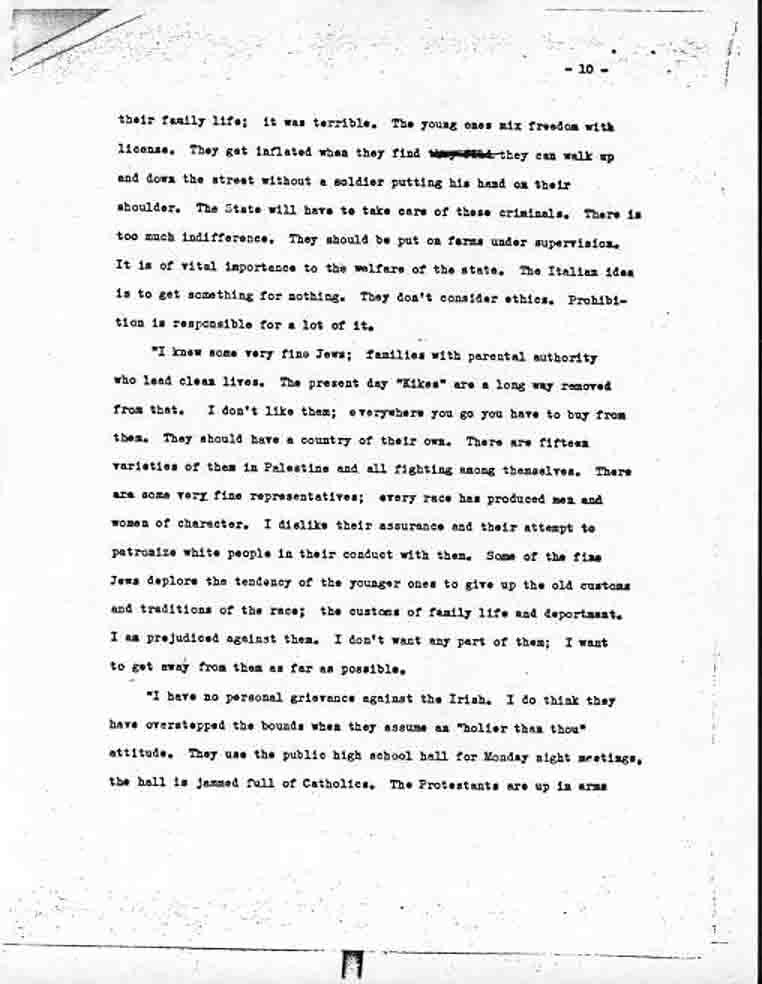
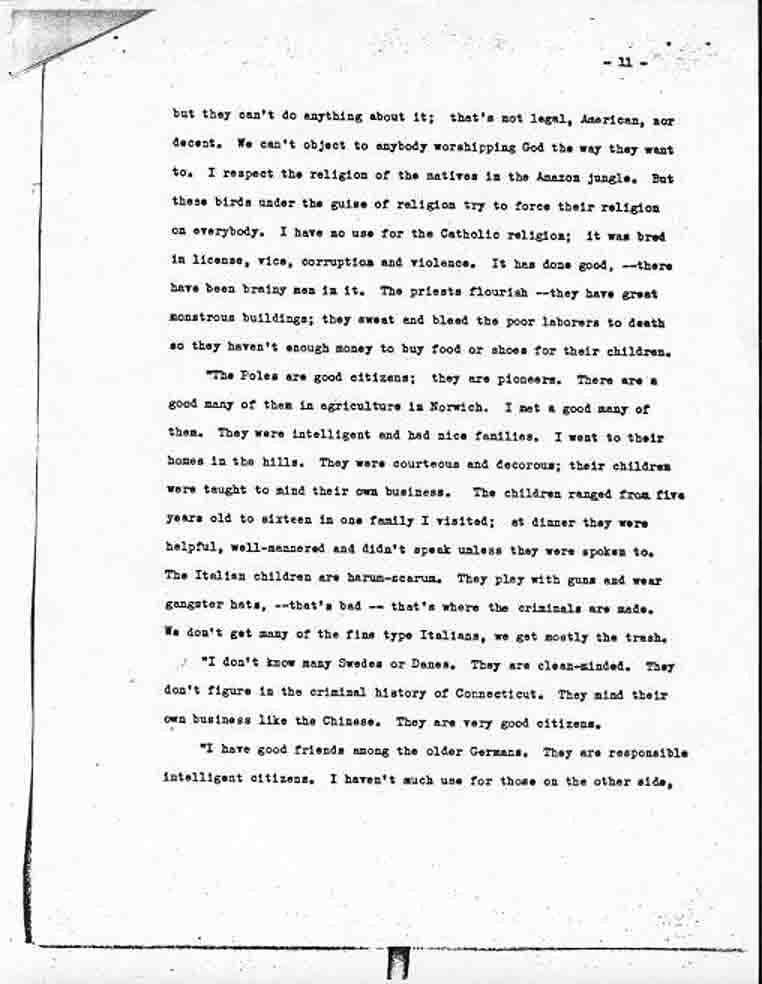

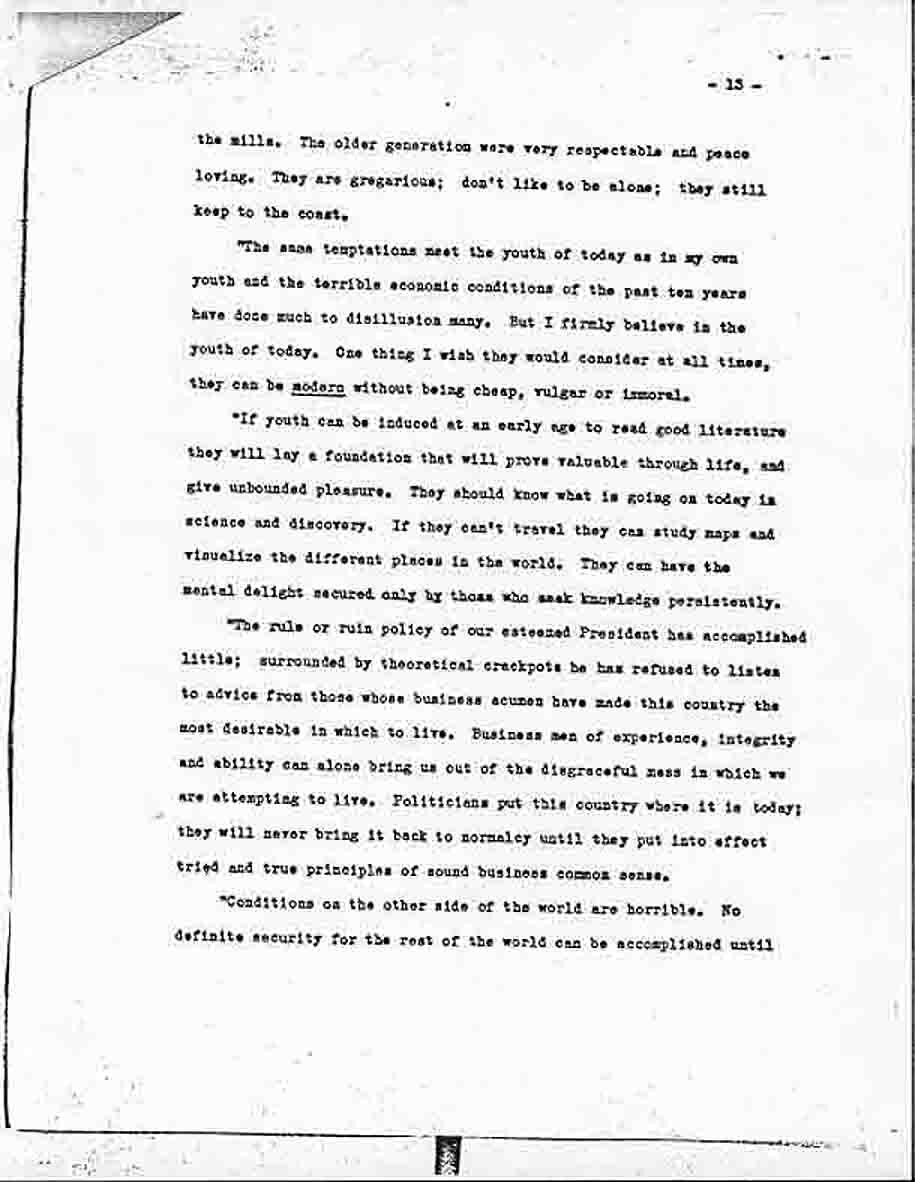
b] Mr. Kenneth B. Morgan was interviewed by John P. Kilgore on July 8, 1940.
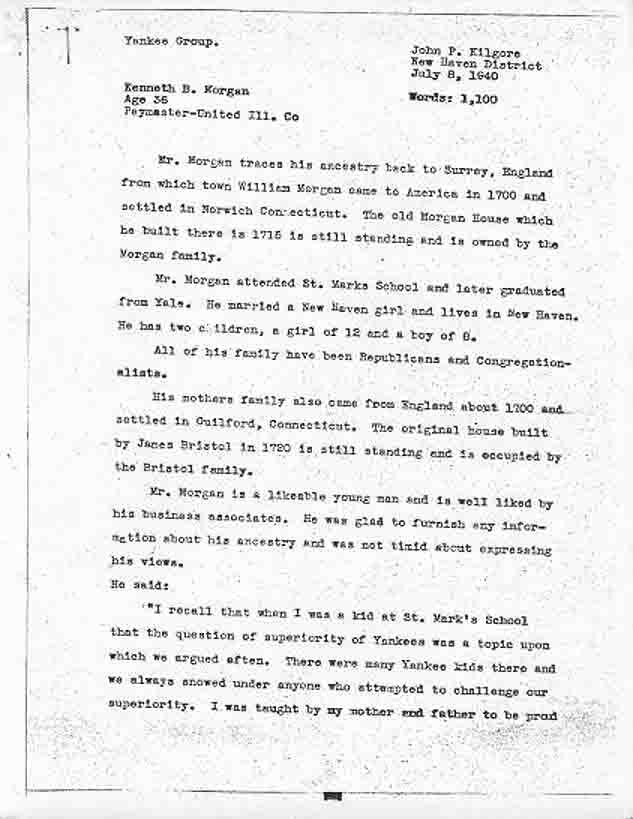
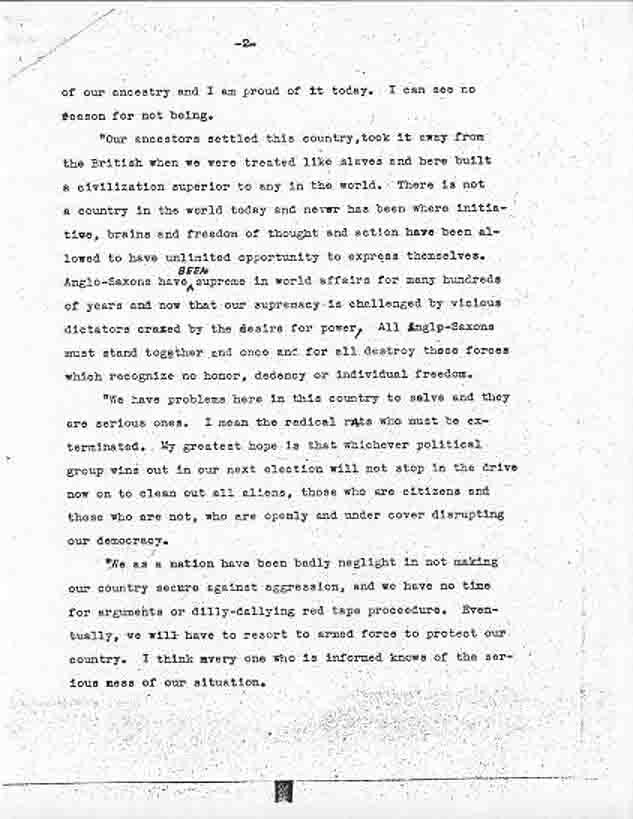
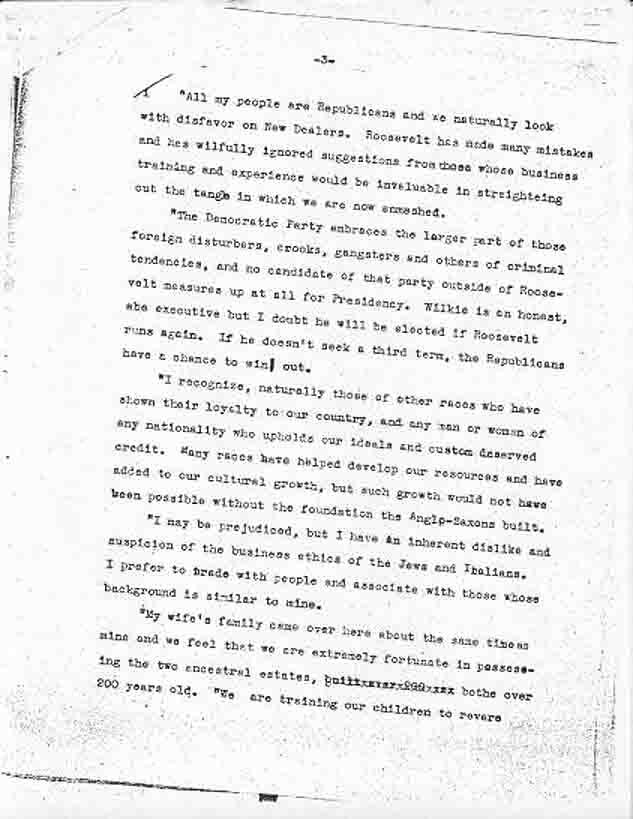

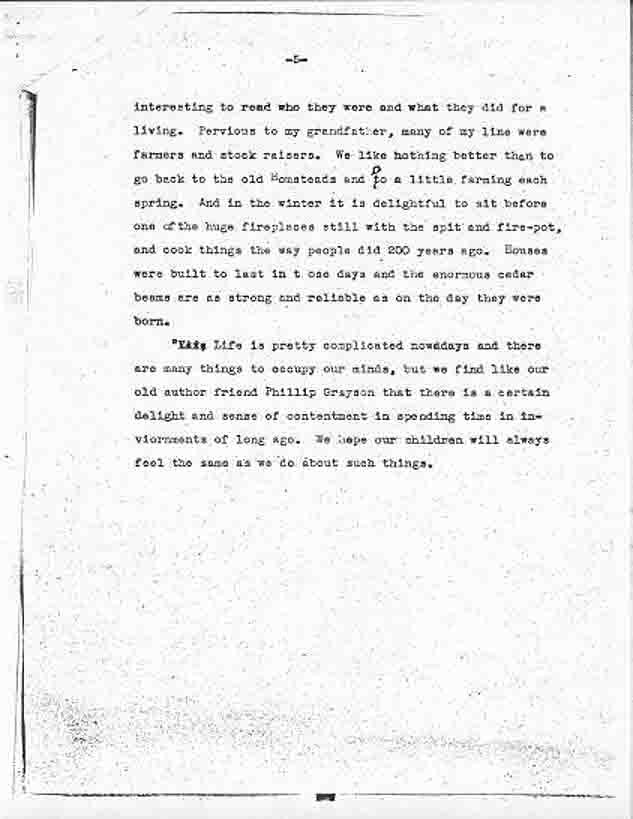
c] Mr. Henry A. Marshall was interviewed by John P. Kilgore on Aug. 12, 1940.
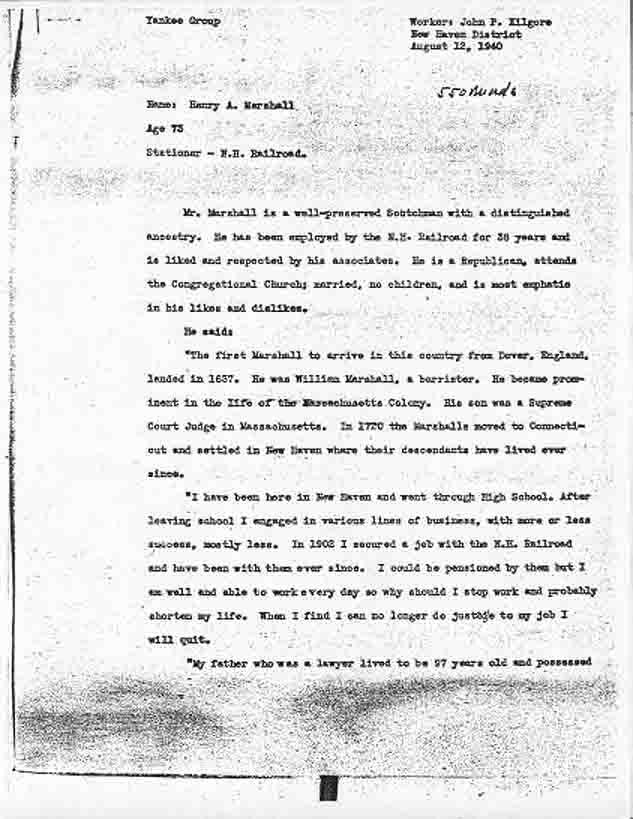
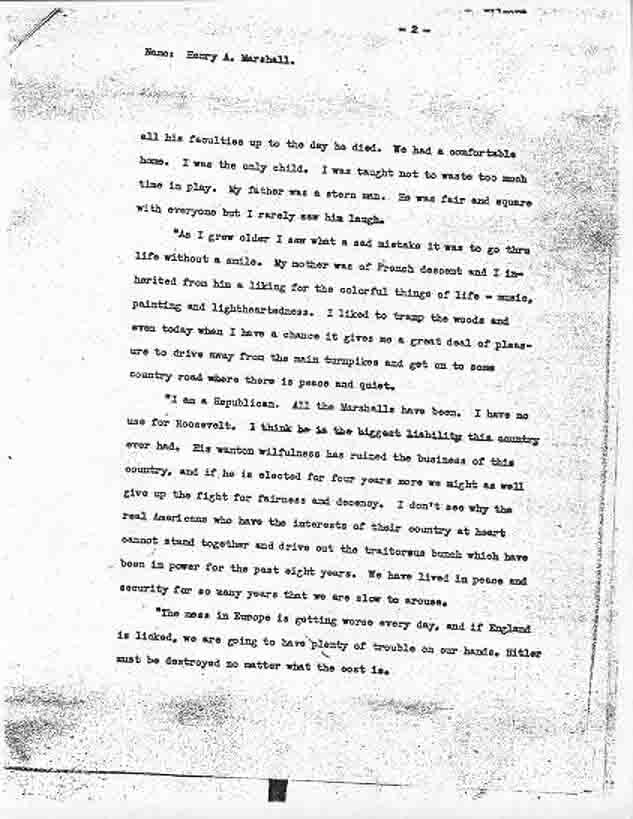
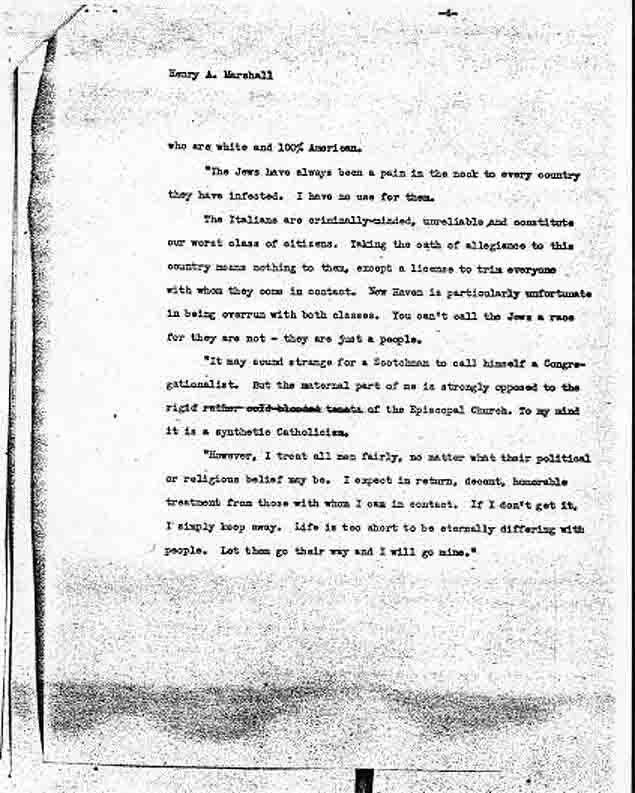
III.Second Generation Americans (an interview of a Jewish man and of an Afro-American in Bridgeport) (WPA Interviews of two minorities traditionally persecuted in the United States):
a] Mr. Raphael Korff was interviewed by Edward Reich on July 7, 1939.


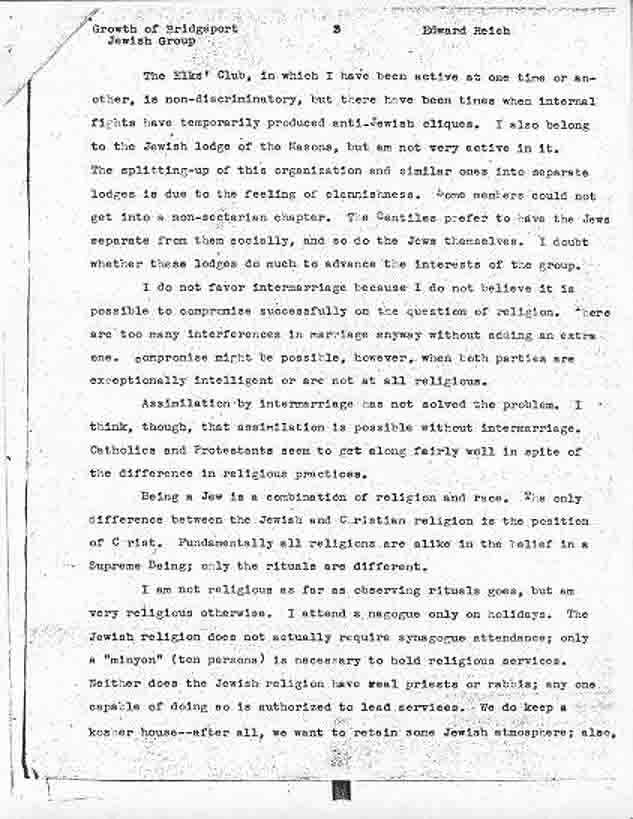
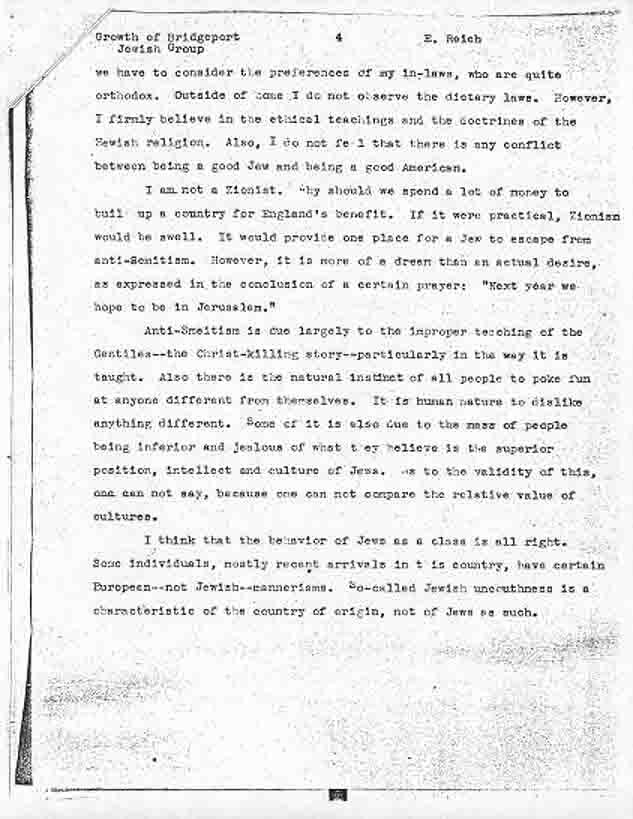

b] Rev. Aaron J. Cuffey was interviewed by George A. Fisher on Jan. 18, 1939.
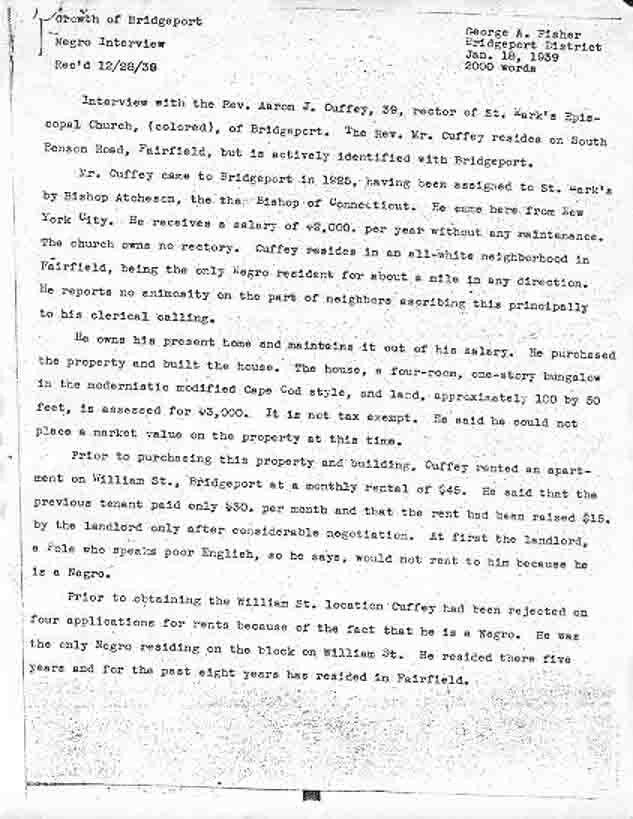
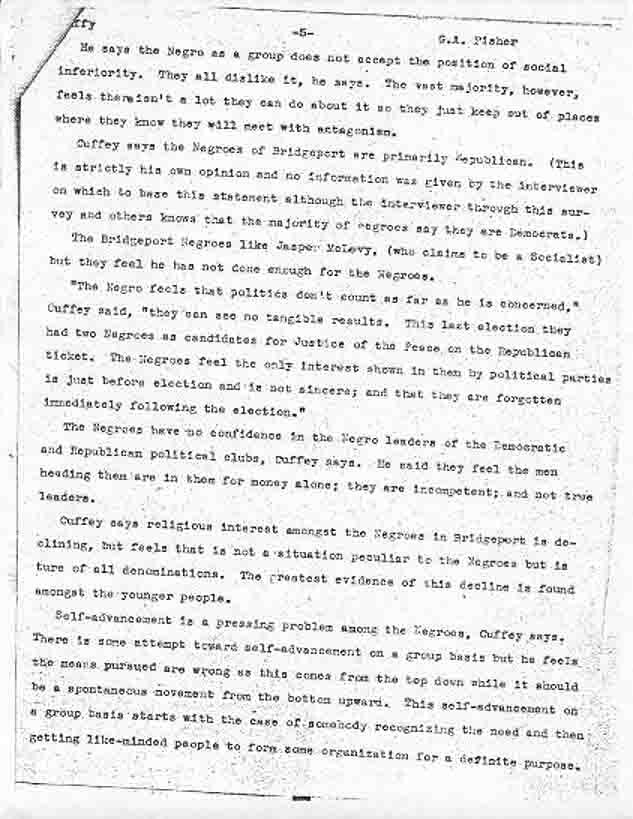

IV. Second Generation American: Marshall V. Rourke one of the WPA interviewer's, interviews himself on Jan. 4, 1939 (WPA Interview done by an Irish WPA Interviewer).
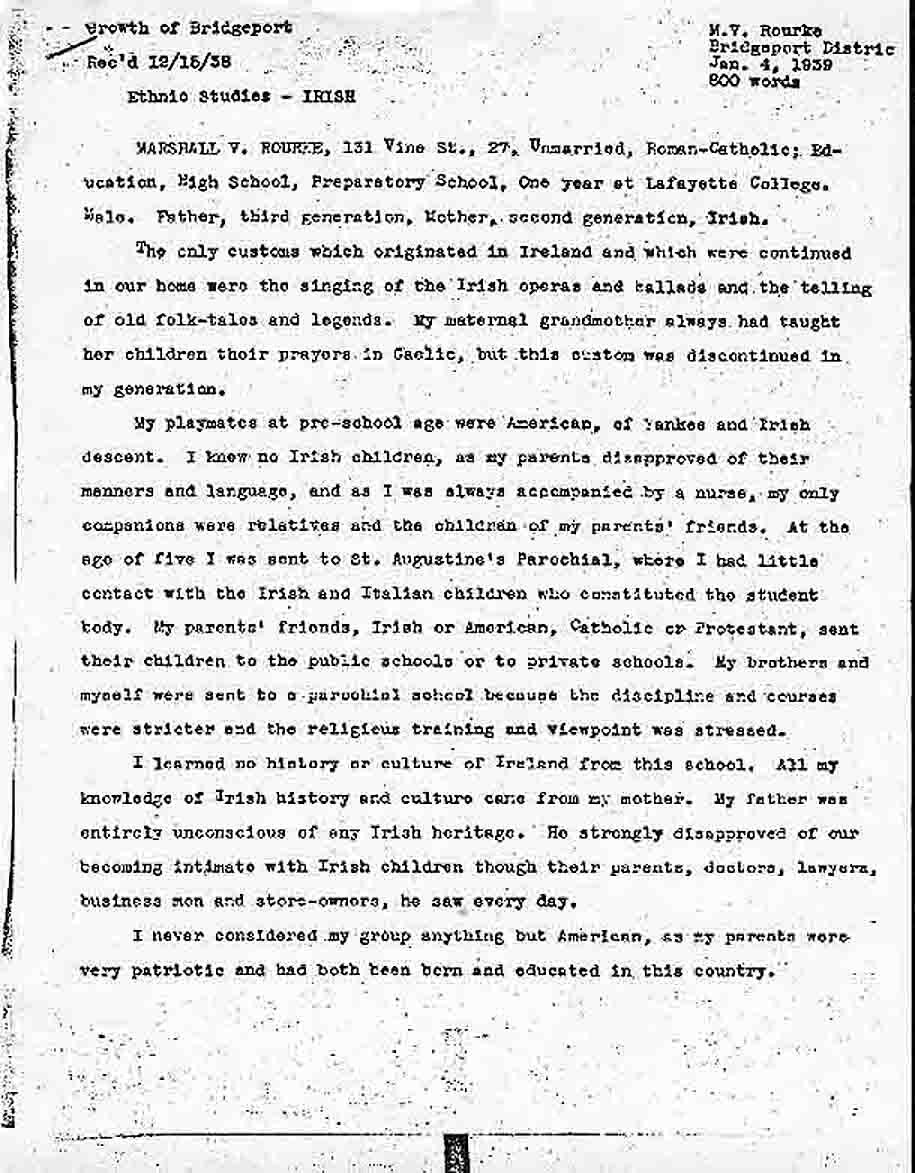
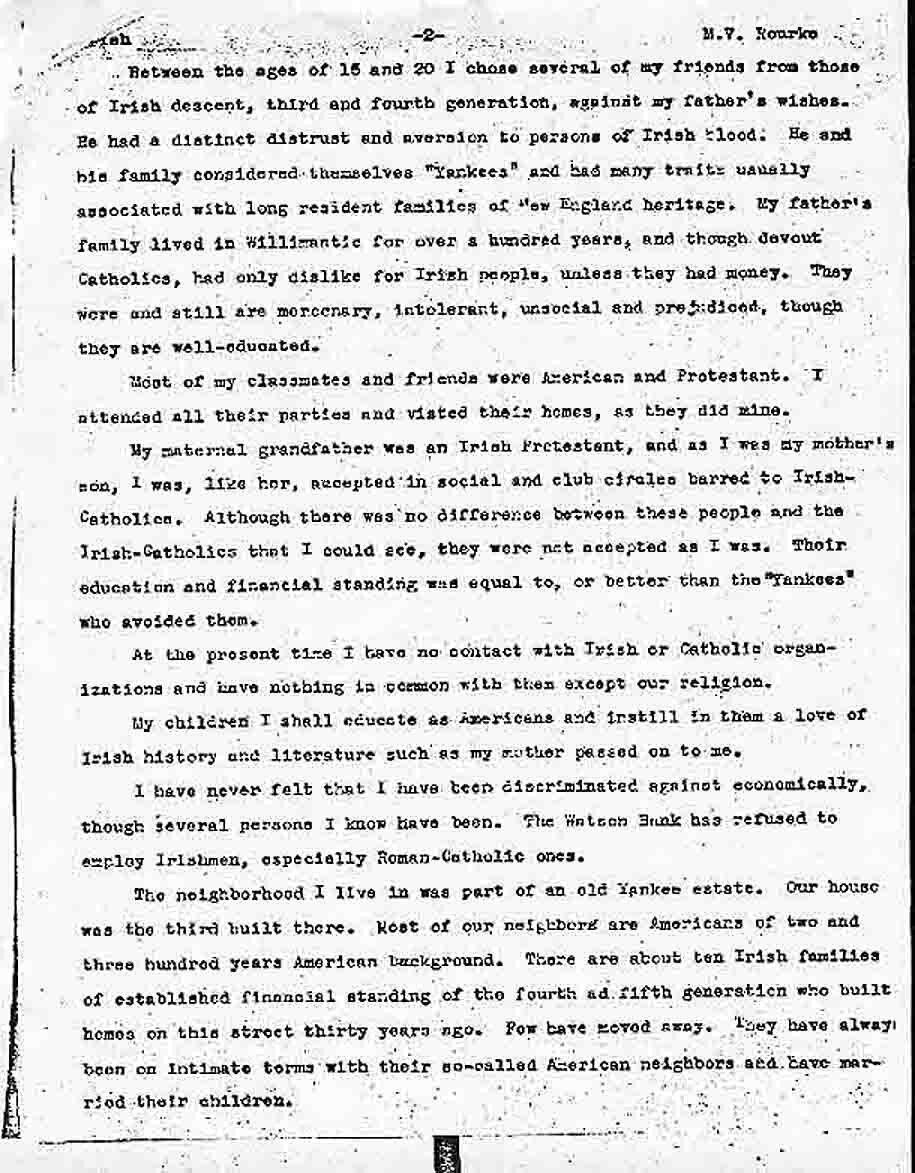
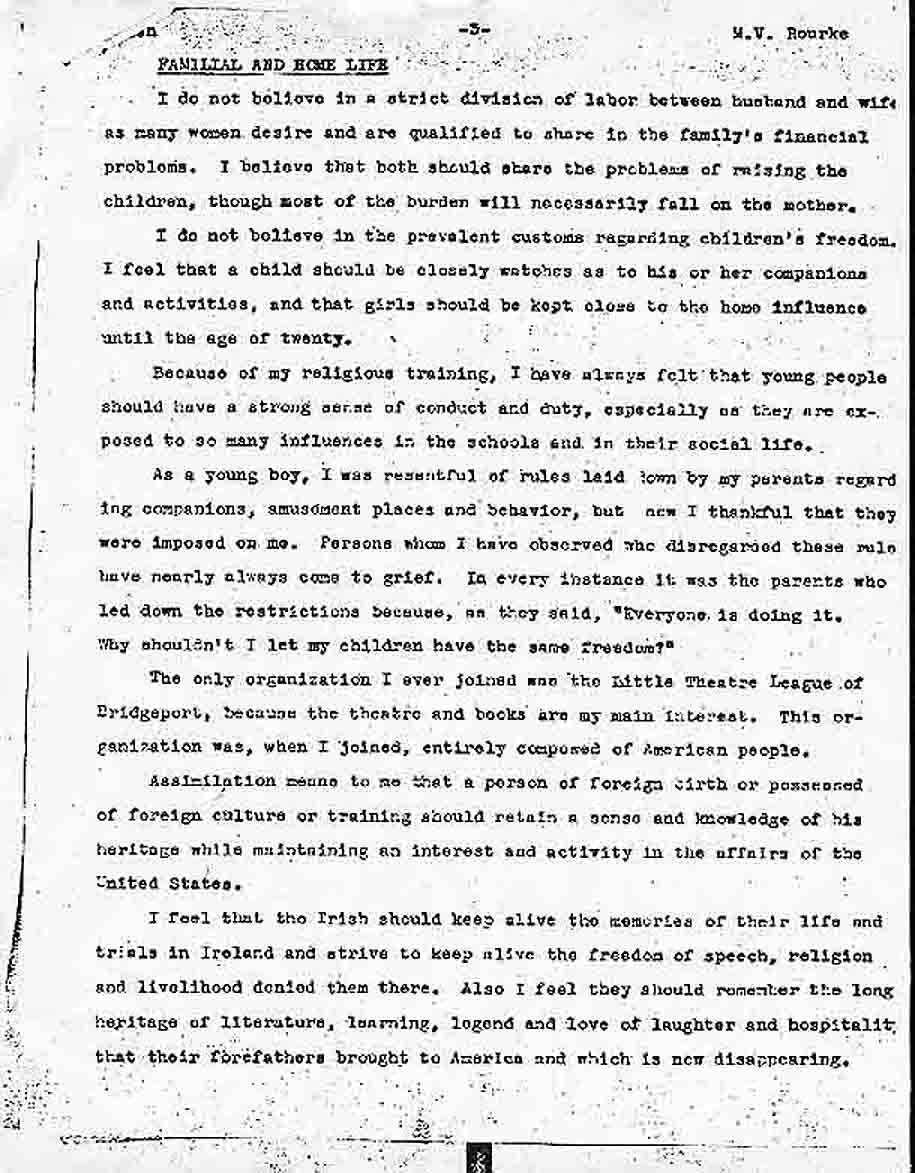
[These excerpts are taken from From the Old Country: An Oral History of European Migration to America, ed. by Bruce Stave and John Sutherland, used with permission of the editor (These include 1930's interviews of Sicilian-American, two Irish-Americans, and a Ukrainian-American).]
While Mrs. Schread may have resented being talked about "as if we were Negroes or Jews," the Irish, who had suffered the pangs of prejudice, often indulged in equal bouts of discrimination. The testimony of a Bridgeport appliance store owner offered an extreme example of such prejudice.
I've got an Irish partner and I sure am glad about that. I wouldn't trust an Italian as far as I could see, and I'd shoot myself before I linked up with a Jew. I have no use for those Slavic people, and niggers are only good for: laborers....
I don't like all these marriages with foreigners. I think the races should be kept separate. My sister married a Scotsman and that's bad enough, but if she; ever married one of those southern Europeans, the family would disown her. My brother in New Haven&emdash;he's in the telephone company, an engineer &endash; married an Irish girl, and my best girl is Irish. That's the way it should be: Stick to your own kind.... This mixing races is very unwise, I think. I'm an American and I think we should keep the foreigners out, except of course-the educated and professional refugees.
"Sticking to your own kind" frequently had roots in the Old Country. A Ukrainian-American, James Osochowsky, remarked l upon the antagonisms transplanted from Europe to the ethnic neighborhoods of America's cities such as New Haven, where he lived.
Poles we did not like much at first because Poles I had been our landlords. Italians we did not like because they fought against Austria. Russians we didn't like because they, too, fought Austria, and because our people didn't have liberty in Russia, although Ukrainians who came from the Russian Ukraine got along with Russians pretty well. We liked Austria better than Russia because Austria gave us more liberty, and during the war we liked Germans - because we thought it was helping Austria and would help us.
Frank Kovalauskas, a Lithuanian-American from New Britain, Connecticut, elaborated upon the ethnic tension not among the eastern and central Europeans but between the eastern Europeans and the Irish. He had emigrated to the U.S. in 1902 at age 13, his father, a coal miner, having preceded him a few years earlier.
About 1905 I decided to go to Philadelphia and find different work for myself. By that time I could speak English a little and could understand it. My first job was dishwashing in a restaurant. Afterwards I worked as a shortorder cook and counterman. Then I went to work in the kitchen of a big hotel. I worked there for about a year and was well satisfied with my work and my employer was satisfied with me. On this job was the first time that being a Lithuanian worked against me. The second chef's job was open in our kitchen and I tried to get it. The boss told me I was a good worker and he liked me but he couldn't give me the job because I was neither French or German. Those were the only kind of people he would have for the chefs in the kitchen.
A short time later my father bought a grocery store in New Philadelphia and asked me to come home and help him run it. I went back and went to work with him. Our business went fairly well. There were many Lithuanian families in the town and they traded with us; so did some of the Germans. The Irish would not come into the store. This was because they had been enemies of the Lithuanians and Poles . . . ever since they started coming in from the old country.
I remember when I was a boy and first came here, they used to throw stones at me when I walked in the street. Every time I went down to the store for my mother, I had a fight with them. The men that worked in the mines had trouble too. The Irish "Molly Maguires" would start fights with them when they were going to and from work. Some people were killed.
One time I remember in Shenandoah, the Lithuanians and Poles formed an army and went out to fight the "Molly Maguires." They beat up the Irish that time and didn't have much trouble with them later.
My father told me about one time when work was slack, he went to New Philadelphia with a friend of his to look for work there. They went into a -saloon and asked the owner where they could find a place to live; he was Irish. When he heard them try to talk English, he started to yell, "Get out of here, you Hunkies. We don't want any, of you in this town," and he chased them out without waiting for [them to] pay for the drinks they had.
The anti-Catholicism of some New England Yankees left an indelible mark on the father of a Polish priest, and more emphatically on the priest himself:
Some of the other nationality people, they cook more macaroni and greens like the Italians make. And some of the Italian people, they have the cooking like other nationalities. Why is this thing&emdash;well, because the people they are being like one now.
[However], in Italy all the people from one place they all do the same things, and if you see one Italian from one place it's just like you see all of them. That's why you see the difference from the Sicilian, the Abruzzese, the Romani, and all the rest of the people. When I come to this country all people from one place were staying together and the other ones they lived in different places. I went to the East Side because the people from my place were living there.
Regionalism among Italians was further elaborated upon by Mr. Paumi, who had come to the United States in 1910 from Messina, Sicily, and had worked at Bridgeport's Remington Arms plant for almost three decades.
All the Italian people that come to this country, they all went on the East Side or in the North End. The Sicilian people like myself, we all used to live like together on the East Main Street section of the East Side. That time these Sicilians, they were not liked too much by the Castelfranco, the Calabrese and North Italian people because they think they were better people and they said that the Sicilian people they were bad because they used to kill a lot of people in Italy. That's why the Sicilian people, they live like all alone in one group on East Main Street and Howe Street.... Out of all the people the Sicilians they still have the habits like the mother and father. All the other Italian people . . . are not the same like we are.
The Irish were sandwiched between their immigrant successors and those who preceded them. The sometimes hated, sometimes envied Yankees did not put out the welcome mat, and stories of "Irish Need Not Apply" are legion throughout New England. Like so many others escaping the potato famine, Mrs. Schread's grandfather emigrated to the United States during the 1850s. The 60-year-old widow explained about her family's relations with Yankees.
Bull's Head [a neighborhood] was filled with Irish families, who always seemed to gather together. The Yankees had nothing to do with them, and I still think they resent us. When we children were growing up, Father bought a house on Lumber Street, a Yankee district. We saw very little of the Yankees when I was a child, and at school were pointed out as "Irish Paddies." All my parents' friends and mine were Irish, as they still are.
We had a happy life on Lumber Street. There was my brother and two Sisters and my parents, and relatives from everywhere came to visit us. We used to sing and dance to all the old Irish songs and ballads and dance the Irish jig. We were always taught to be proud of being Irish and Catholic, and we knew all the history and legends of Ireland and followed the happenings in Ireland, as we did the local news. I often think that some of the Irish people who pretend not to be Irish and look down on their own kind are really ashamed of their background and ignorant of their heritage. [All of Mrs. Schread's brothers and sisters had become Protestant.]
The daughter of an old Irish family which was well-to-do and respected for many years, as they still are, scorns all the Irish though she went to an Irish preparatory school and married an Irishman. She is society editor on one of the newspapers and tried not to print notices about Irish-Catholic organizations, saying that weddings don't leave enough space...
Mrs. Schread goes on to tell how when married she moved to Washington and Park Avenues in Bridgeport, there were only Yankees nearby, no Irish.
It was two years before our neighbors spoke to us, but when we had a big fire, our snootiest neighbors offered us rooms for the night. I enjoyed telling her we had several friends who would look after us.
We had a farm in Stepney for the summer when the children were small. There were no Irish families there then, and we saw only the Yankees, except on Sundays when our friends would come visiting. The Yankees were nice to us in that neighborhood, but they were never intimate with us. We used to visit back and forth, but they talked about us as if we were Negroes or Jews and the children overheard things that were unkind or prejudiced. I think they were polite to us because of my husband's business, but even the Hawleys, for whom he worked for so many years, always tried to keep him feeling inferior to them. Now, in that neighborhood there is a Catholic priest who has nearly eliminated the old prejudice. The Irish Catholics built him a nice church and community house where all the denominations like to hold their entertainments. They have clubs and teams of all kinds, and the children in Stepney and Long Hill would rather go to St. Theresa's than anywhere else.
